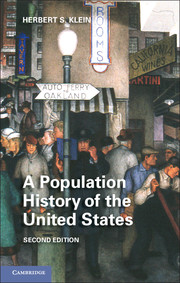Book contents
- Frontmatter
- Contents
- Graphs, Maps, and Tables
- Introduction to the Second Edition
- Introduction to the First Edition
- 1 Paleo–Indians, Europeans, and the Settlement of America
- 2 Colonization and Settlement of North America
- 3 The Early Republic to 1860
- 4 The Creation of an Industrial and Urban Society, 1860–1914
- 5 The Evolution of a Modern Population, 1914–1945
- 6 The Baby Boom and Bust and the New New Immigrants, 1945–1970
- 7 An Advanced Industrial Society, 1970–2011
- Appendix Tables, Graphs, and Maps
- Bibliography
- Index
- References
2 - Colonization and Settlement of North America
Published online by Cambridge University Press: 05 June 2012
- Frontmatter
- Contents
- Graphs, Maps, and Tables
- Introduction to the Second Edition
- Introduction to the First Edition
- 1 Paleo–Indians, Europeans, and the Settlement of America
- 2 Colonization and Settlement of North America
- 3 The Early Republic to 1860
- 4 The Creation of an Industrial and Urban Society, 1860–1914
- 5 The Evolution of a Modern Population, 1914–1945
- 6 The Baby Boom and Bust and the New New Immigrants, 1945–1970
- 7 An Advanced Industrial Society, 1970–2011
- Appendix Tables, Graphs, and Maps
- Bibliography
- Index
- References
Summary
The distribution of the pre-columbian Amerindian population would have as much influence on the settlement patterns of the northwestern Europeans who would colonize the Americas as did the Iberians who had preceded them. Lacking large numbers of Amerindians in settled agricultural villages, it was the Portuguese servile labor plantation model that they adopted, rather than the Spanish multiethnic free labor one. This required the subsidization of the migration of a large servile labor force, both indentured whites and African slaves, in order to produce tropical and semitropical export crops for the European market. It also meant that European immigrants, both free and indentured, were drawn to the economically most viable zones, which in turn were not the healthiest for these migrating persons. The West Indies and the southern North Atlantic continental shore were zones where Europeans often had higher morbidity and mortality rates than in their places of origin and lived much shorter lives than those who migrated to the colder, but poorer northern continental regions. Faced by a constant shortage of labor everywhere, Europeans not only turned to servile laborers but also experimented with new mechanisms of inheritance and marriage patterns in order to retain labor in extended family units. Given the bias of the migrants toward the preponderance of young males, the age of marriage for colonial men would rise above European norms and for colonial women, it would fall below those norms in these new settlements. Paradoxically, in the poorest and coldest colonies, the European immigrants would achieve higher rates of fertility and lower rates of mortality and lived longer and healthier lives than were being experienced in contemporary Europe. Finally, the general availability and abundance of food in these new colonies guaranteed that the North American populations in general would become the best fed and tallest populations in the North Atlantic world.
- Type
- Chapter
- Information
- A Population History of the United States , pp. 34 - 60Publisher: Cambridge University PressPrint publication year: 2012



